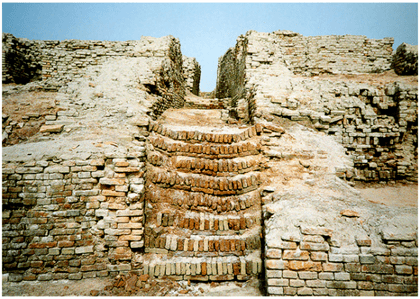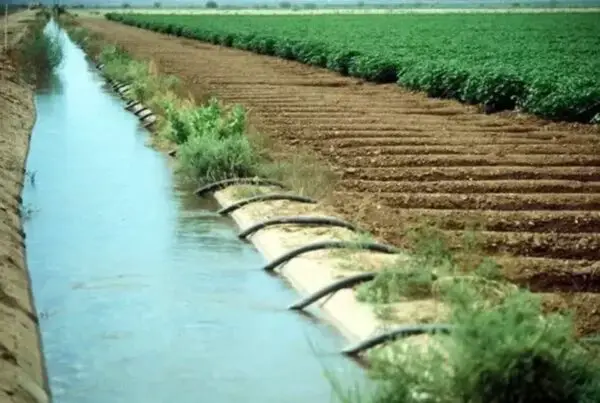Furrow irrigation is a common irrigation method that has been used for thousands of years.
It involves channeling water down long, narrow trenches called furrows that have been cut into the soil between crop rows. The furrows serve to effectively distribute water across a field using gravity.
When this irrigation is utilized, the field is first laser-leveled to enable uniform water flow.
The furrows are commonly 3-4 inches deep and around 20 inches apart. Water is introduced at the highest point and allowed to travel down the small trenches.
As the water moves through the furrows, it infiltrates the soil and is absorbed by the plant roots on either side. Excess water collects at the lower end of the field.
Furrow irrigation layout
Main elements of layout include:
- Main supply canal or pipeline: This is the primary source of water for the field, which may be fed by a reservoir, well, or river.
- Head ditch or pipeline: The head ditch or pipeline runs along the top edge of the field and receives water from the main supply canal or pipeline. It is designed to distribute water evenly to the furrows.
- Furrows: These are the small, parallel channels that run down the field, typically between crop rows. They are designed to convey water from the head ditch to the crops.
- Crops: The crops are planted on the ridges between the furrows, allowing them to access water as it infiltrates the soil.
- Tail ditch or drainage channel: This is located at the bottom edge of the field to collect excess water that runs off the end of the furrows. The water may be reused or discharged from the field.
- Check structures: These are small dams or gates placed in the head ditch or furrows to control the flow of water and ensure even distribution.
- Turnouts: These are openings or gates along the head ditch that allow water to flow into the furrows.
- Access roads: These are necessary for the movement of people and equipment during irrigation and other field operations.

Advantages and disadvantages
Advantages:
- Low initial cost: This irrigation systems are relatively inexpensive to set up compared to other irrigation methods like sprinkler or drip irrigation.
- Simplicity: Simple method that doesn’t require complex equipment or advanced technical knowledge.
- Suitable for certain crops: Works well for crops that are planted in rows, such as corn, soybeans, and cotton.
- Efficient water use: When properly managed, it can be efficient in water use, especially in soils with high water-holding capacity.
- Fertigation: It allows for the application of fertilizers along with water (fertigation), which can save time and labor.
Disadvantages:
- Uneven water distribution: It may result in uneven water distribution, with the upper end of the field receiving more water than the lower end.
- Water loss: If not managed properly, furrow irrigation can lead to significant water losses through deep percolation and runoff.
- Labor-intensive: Requires regular maintenance and labor to ensure proper water flow and to prevent breaches in the furrows.
- Soil erosion: Poorly designed or managed it can cause soil erosion, particularly in fields with steeper slopes.
- Limited application to certain soil types: Furrow irrigation may not be suitable for sandy soils with low water-holding capacity or for soils that easily form crusts.
- Salinity build-up: In arid regions with high evaporation rates, furrow irrigation can lead to salt accumulation in the soil if proper drainage is not maintained.
- Limited flexibility: Furrow irrigation may not be as flexible as other methods in terms of water application rates and timing.
Furrow irrigation equipment
- Water source: A reliable water source, such as a well, canal, or reservoir, is essential for furrow irrigation.
- Pump: A pump is used to lift water from the source and pressurize it for distribution through the system.
- Main pipeline: A main pipeline, often made of PVC or aluminum, carries water from the pump to the field.
- Valves: Valves are used to control the flow of water from the main pipeline to the distribution pipes or ditches.
- Distribution pipes or ditches: Water is conveyed from the main pipeline to the furrows through a series of distribution pipes or open ditches.
- Siphon tubes or gated pipes: Siphon tubes or gated pipes are used to direct water from the distribution pipes or ditches into the furrows.
Deep furrow irrigation
This method is particularly useful in arid and semi-arid regions where water conservation is crucial.
- Furrow dimensions: Deep furrows are typically 20-30 cm (8-12 inches) deep and 40-60 cm (16-24 inches) wide, which is deeper and wider than traditional furrows.
- Water efficiency: The deeper and wider furrows allow for better water infiltration into the soil, reducing runoff and evaporation losses. This results in more efficient water use compared to traditional furrow irrigation.
- Crop growth: Deep furrows provide a larger wetted area around the plant roots, promoting better root development and nutrient uptake. This can lead to improved crop growth and yield.
- Irrigation intervals: Due to the increased water storage capacity of deep furrows, irrigation intervals can be extended, reducing the frequency of irrigation events and saving labor and energy costs.
- Soil moisture conservation: The deeper furrows help maintain soil moisture levels for longer periods, which is particularly beneficial in areas with high evaporation rates or low rainfall.
- Suitable crops: Deep furrow irrigation is suitable for crops with deep root systems, such as corn, sorghum, and cotton.
- Soil suitability: This method works best in soils with good water-holding capacity and moderate to low infiltration rates, such as clay loam or silty clay loam soils.

Conclusion
Furrow irrigation is valued for its efficiency and cost-effectiveness in watering row crops, making it well-suited for farms growing corn, soybeans, cotton, wheat, sugarcane, and more.
It provides good soil aeration while avoiding water logging compared to flood irrigation. Furrow irrigation does have its challenges, including erosion, runoff, and labor requirements for furrow preparation.
However, proper design, installation, and management are essential to maximize its benefits and minimize its drawbacks.
As with any irrigation method, the choice of furrow irrigation should be based on factors such as crop type, soil characteristics, water availability, and climate conditions.



